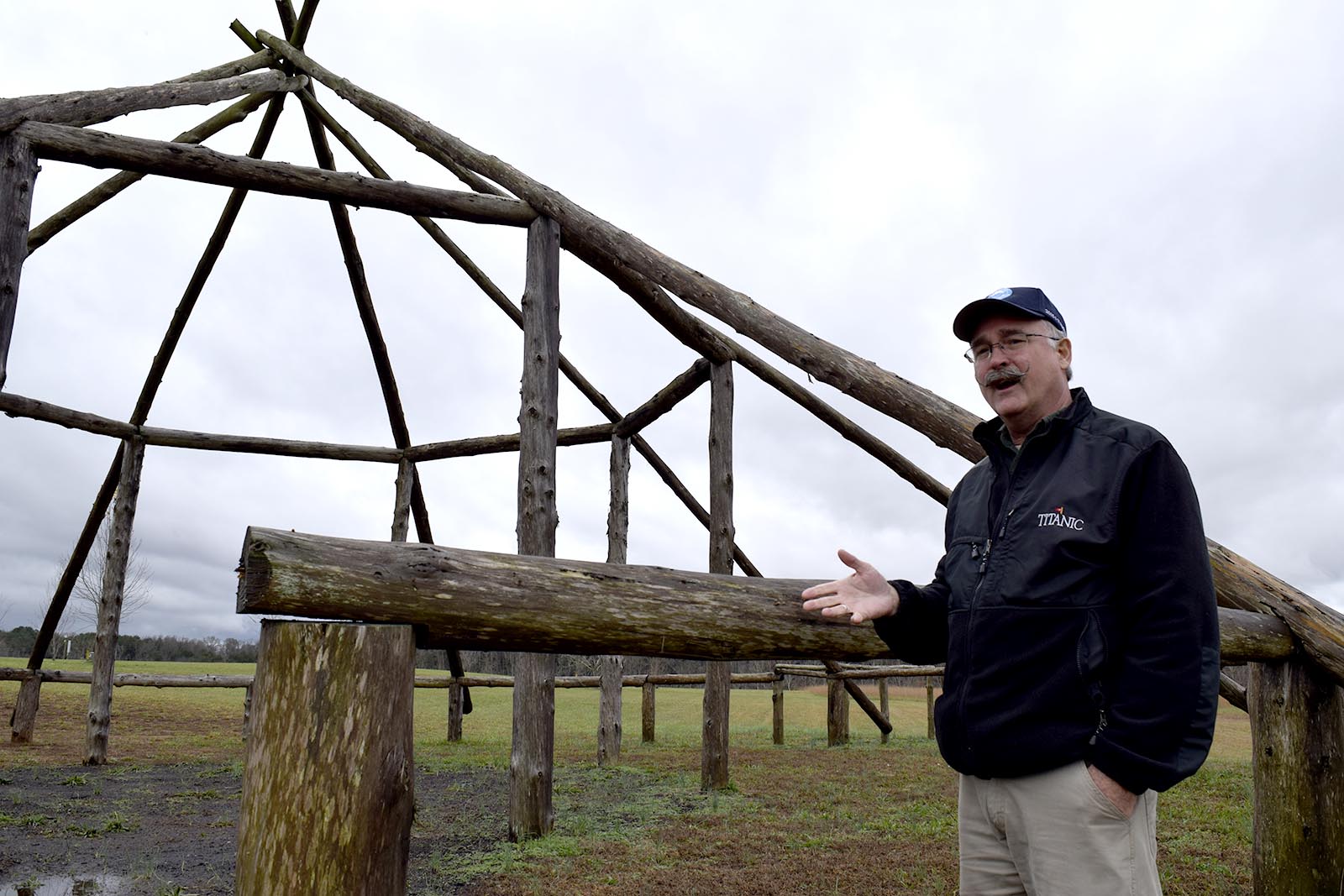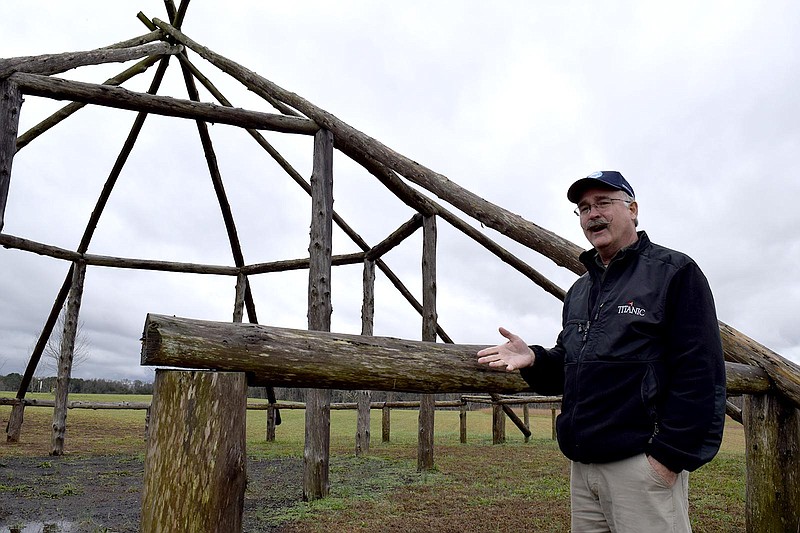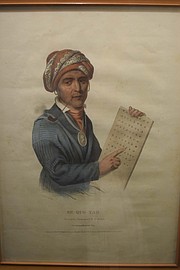 Sequoyah Birthplace Museum manager and director Charlie Rhodarmer talks about a Congressional bill that seeks to return ancestral lands in Monroe County to the Eastern Band of Cherokee Indians as he walks around a replica town house that is said to have held up to 500 people for events and as protection.
Sequoyah Birthplace Museum manager and director Charlie Rhodarmer talks about a Congressional bill that seeks to return ancestral lands in Monroe County to the Eastern Band of Cherokee Indians as he walks around a replica town house that is said to have held up to 500 people for events and as protection.VONORE, Tenn. - More than 177 years after most of the Cherokee were forcibly removed from Tennessee, Georgia and North Carolina - and a generation after several significant historical sites were flooded by a Tennessee Valley Authority project - the Eastern Band of Cherokee Indians could get back 76 acres of homeland, including sites where the tribe once was headquartered.
At the Tanasi Memorial, built to mark the Cherokee capital that now lies under the Tellico Reservoir, the view of the remaining land is much as it was 200 years ago. No houses or power lines are in sight, and water birds skim the river's surface.
Important sites
› Sequoyah Birthplace Museum: Opened in 1986, the museum’s exhibits tell the story of the Cherokee, their family life, customs, beliefs and the tragedy of the Trail of Tears when Cherokee in East Tennessee were forced to go to Oklahoma in the 1830s. Sequoyah was born in 1776 in the Cherokee village of Tuskeegee, about one-half mile from the museum.The museum grounds are also part of the Trail of Tears National Historic Trail and contain an amphitheater, a Cherokee Memorial burial mound, a town house, smithy and log home and other exhibits. The 46-acre campus around the museum has a 1.5-mile trail around the perimeter of the property with views of the lake and marsh.› Tanasi: A memorial to the Cherokee town of Tanasi, Tennessee’s namesake, stands on an 18-acre site near the water’s edge a few hundred yards from the actual site that now lies under the waters of Tellico Reservoir. Tanasi was a principal town and capital in the early-1700s.› Chota: A memorial to the Cherokee town of Chota stands at the end of an 8.5-acre peninsula, part of the 18-acre preserve that also contains the Tanasi site. The site’s memorial is arranged in a circle replicating the footprint of the town house that stood at Chota with memorials to the seven clans of the Cherokee. Chota was at its height in the mid-1700s.Source: Sequoyah Birthplace Museum, Tennessee Overhill, Tennessee Encyclopedia of History and Culture
Why it’s important
The sites contained within the 76 acres include the Cherokee towns of Tanasi and Chota, two principal towns and de facto capitals of the Overhill Cherokee living in East Tennessee, and the birthplace of Sequoyah, the man who invented the Cherokee’s written language and established the first national bilingual newspaper. The bill, if passed, would make the 76 acres reservation land and would allow the tribe to build facilties for interpretive and educational programs and other facilities.
This important Cherokee site and others could be returned to tribal hands, thanks to a congressional bill introduced in September by U.S. Rep. Chuck Fleischmann, R-Tenn. Tribal leaders began discussions with federal officials earlier this year.
Patrick Lambert, the principal chief of the Eastern Band of Cherokee Indians, said the Eastern Band Cherokee Historic Lands Reacquisition Act would be historic for the descendants of the Overhill Cherokee - so named for crossing the Appalachians to live in East Tennessee and the Little Tennessee River Valley.
In the mid-1980s, "the Eastern Band of Cherokees were deliberating with TVA about securing certain tracts of land that would become Tellico Lake shoreline," Lambert said. "These were lands that held special value to the Tribe because of their special cultural significance."
The bill seeks to place the land in trust status, a designation Lambert said has been used by other tribes for similar purposes.
"This would be a very meaningful action, allowing the lands to again become tribal reservation," he said. "They would be under our control and ownership as official homelands of the Overhill Cherokee once again. This would, in fact, represent the official and formal return of the Cherokee to their homeland - to what is now known as Tennessee."
The bill stipulates gambling operations cannot be established on the land, and any shoreline work would be subject to TVA approval.
The Tellico Reservoir stretches along 33 miles of the Little Tennessee toward the Appalachian Mountains. TVA acquired 37,900 acres for the reservoir that created 357 miles of shoreline and 15,560 acres of water surface.
Large areas of Cherokee ancestral lands along the Little Tennessee River were inundated behind the 129-foot-high Tellico Dam in 1979, covering sites of historic tribal communities of the Overhill Cherokee, places like Chilhowee, Tallassee, Citico, Chota, Tanasi (from which Tennessee drew its name), Toqua, Tomotley, Tuskegee and Mialoquo.
The impoundment of the river displaced 276 families. Some of them sold willingly to TVA. Holdouts had to be forced out, however, through condemnation, according to TVA spokesman Scott Brooks. There were no existing Cherokee communities there when the reservoir was filled.
Although the controversial Tellico Dam roused objections from the tribe, TVA remained sensitive to Cherokee concerns, Max Ramsey said. Ramsey worked for TVA in the 1970s when the dam was planned and built. He now works with the Eastern Band of Cherokee Indians in future planning and other affairs.
At that time, archaeologists worked to identify the significant sites and, in some cases, move important historic structures such as the foundations of Fort Loudon to land above the water line. TVA built Cherokee memorials at the Tanasi-Chota site and helped establish the Sequoyah Birthplace Museum in Vonore in recognition of the tribe's history and the famous Cherokee who invented the tribe's writing system.
Ramsey, who retired from TVA in 1994, became the museum's first board chairman, a founder of the Trail of Tears Association and an honorary member of the Eastern Band of Cherokee Indians. He said the bill would make 76 acres reservation land.
"That is the early homeland of the Eastern and Western Cherokee," Ramsey said. The three federally recognized tribes of the Cherokee - the Eastern Band of the Cherokee Indians, the Cherokee Nation and the United Keetoowah Band of Cherokee Indians in Oklahoma - all have ties to the Appalachian Mountains and the Little Tennessee River Valley.
"The Cherokee properties that were associated with this, particularly from the standpoint of principal town sites like Tanasi and Chota, [were the subject of] 13 years of archaeology done by the University of Tennessee for TVA. That makes it probably one of the more documented areas of cultural history in the country," Ramsey said.
Ramsey's early work with TVA involved learning what Cherokee leaders wanted to do with the lands affected by the dam. Those in Oklahoma felt the Eastern Band based in Cherokee, N.C., were better situated to take up care of the memorials and operation of the Sequoyah Birthplace Museum.
Operations remained in Cherokee hands through agreements with TVA that allowed for limited uses by the Cherokee, including the operation of the museum and the other historical sites along the Little Tennessee. Since then, changes in the trust process create an opportunity for the Cherokee to gain back the land and continue to establish new memorials and other historical exhibits and educational programs and facilities, according to Ramsey.
The largest tract, 46 acres, comprises the property that houses Vonore's Sequoyah Birthplace Museum, opened in 1986 as a memorial to Sequoyah and Cherokee history. Sequoyah, born in 1776 about a half mile from the museum grounds, fought on the side of General Andrew Jackson against the British and Creek Indians in the War of 1812. He also introduced the Cherokee syllabary in 1821, and in 1828 launched the first bilingual newspaper in the U.S.
The state-of-the-art museum is joined with a Cherokee town house, log cabin, smithy and the Cherokee Memorial mound where remains are interred that were recovered by archaeologists from Cherokee cultural sites before the reservoir was filled.
The museum land is about 12 miles northwest of the 18-acre tract that contains the Tanasi and Chota memorial sites, both former principal towns of the Cherokee.
At these quiet, reflective sites, a memorial to Tanasi stands about 300 yards from the original site just offshore. The Chota Memorial is made up of monument pillars that stand on the locations of the original timbers of the town house recreated at the museum. The Chota site is on an 8.5-acre peninsula that terminates at a circle of monuments and a marker for the Cherokee warrior Oconastota, who died in 1783.
The Sequoyah museum's top official, manager and director Charlie Rhodarmer is excited about the possibilities.
"In all this," Rhodarmer said with a sweep of his hand, "you have who they were as the Cherokee and who we all are as a state."
The land is important to the history of the Revolutionary War and the Civil War, as well, he noted.
"We're planning to do a new exhibit in 2017," Rhodarmer said, but he didn't want to divulge details.
Rhodarmer said the bill could allow development of facilities for staff and space for educational classrooms and other new programs. There also could be facilities that generate income to sustain operations.
Ramsey sees the bill as a step toward unified parallel histories - ones that tell a larger story.
"We're hopeful that in this process we can create a new historic district that would package the various sides of this story, not just the Indian side, of the evolution of what is now Tennessee," he said.
Contact staff writer Ben Benton at bbenton@timesfreepress.com, twitter.com/BenBenton, www.facebook.com/ben.benton1 or 423-757-6569.

